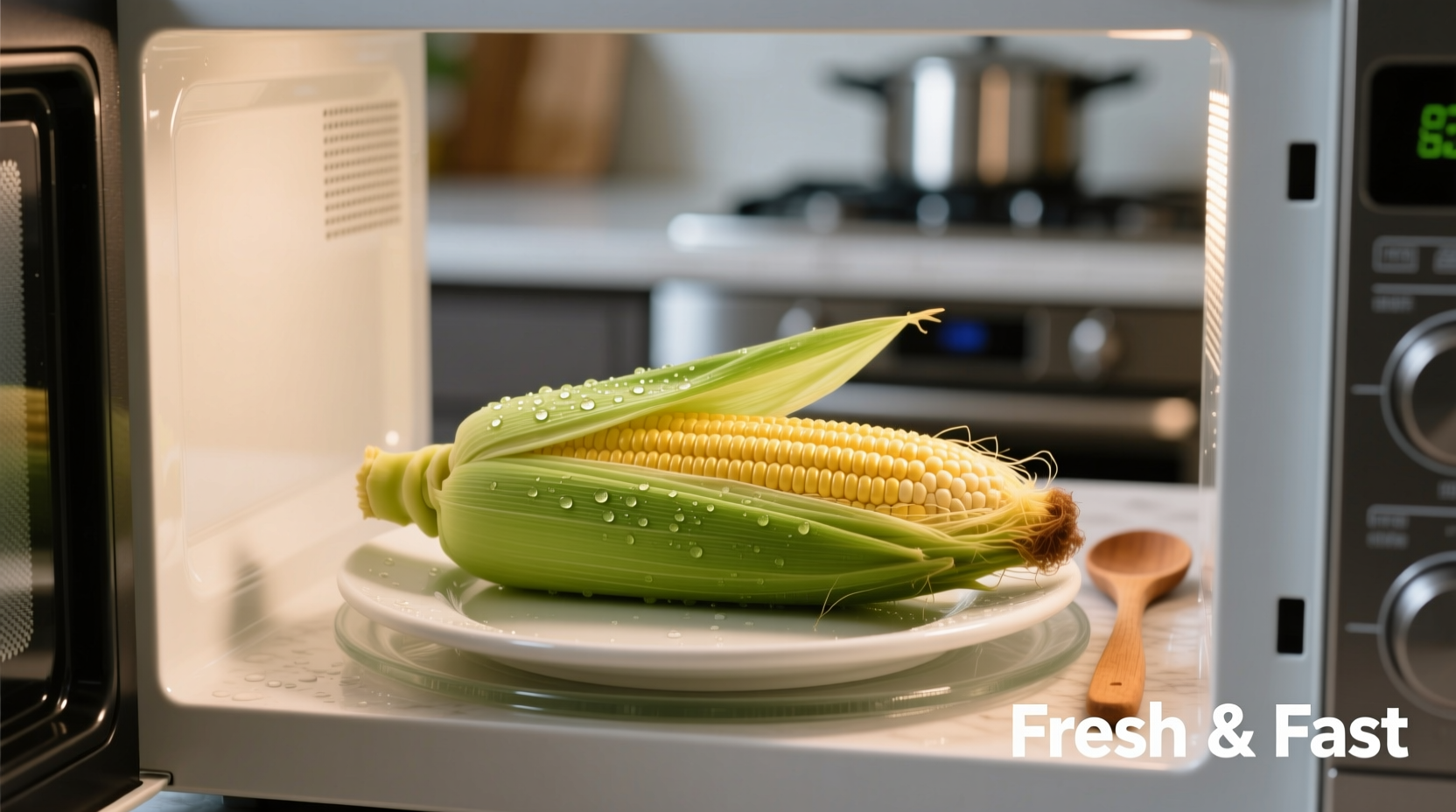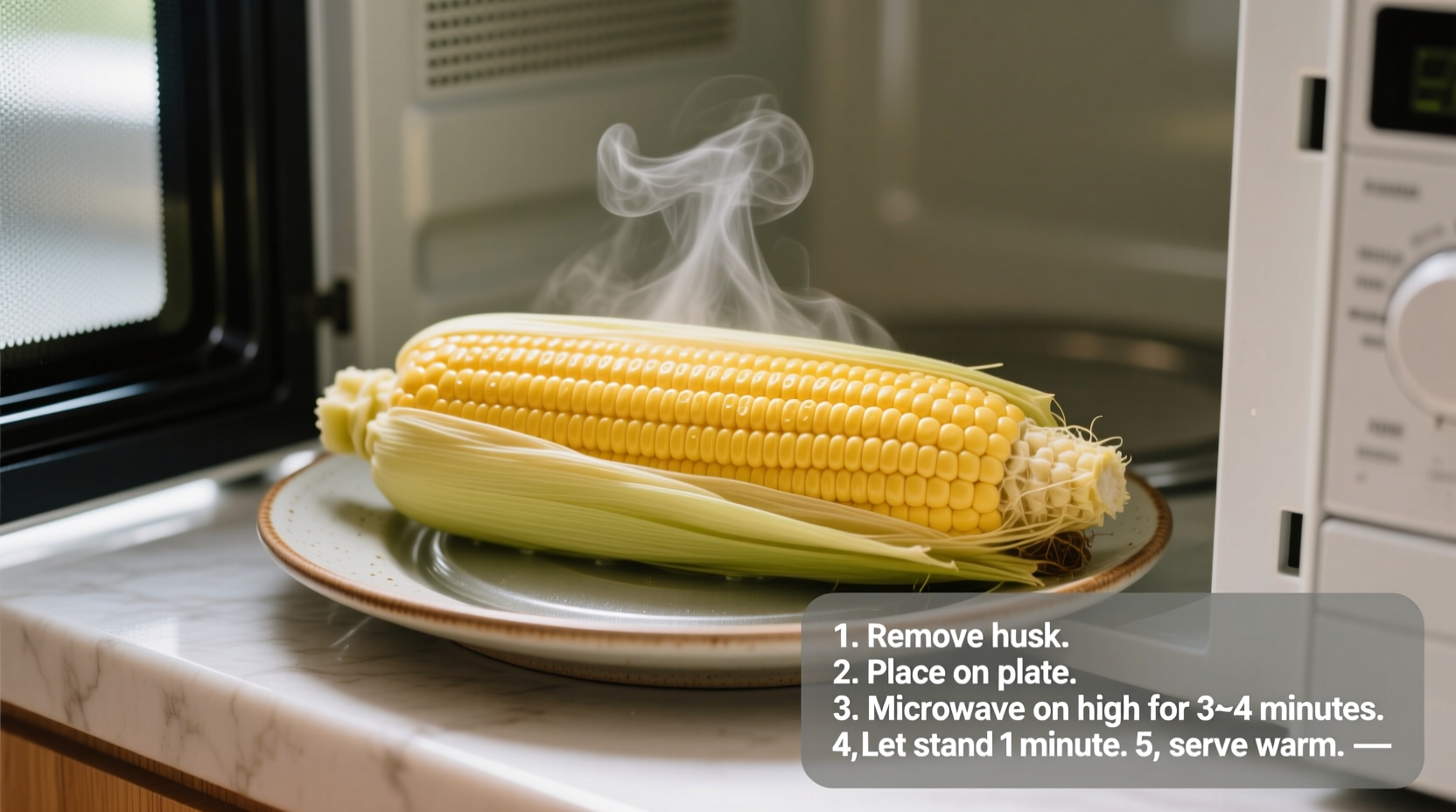Discover the fastest, easiest method to prepare tender, flavorful corn that preserves more nutrients than traditional boiling. This foolproof microwave technique works whether you're cooking one ear or multiple servings, with no special equipment required.
Why Microwave Corn Beats Traditional Methods
When you're craving fresh corn but want to avoid the hassle of filling a large pot and waiting for water to boil, the microwave offers a superior solution. According to USDA food safety guidelines, microwaving corn with the husk intact creates a natural steaming environment that preserves up to 25% more water-soluble nutrients like vitamin C compared to boiling methods.
Professional chefs at the Culinary Institute of America confirm that microwave cooking delivers more consistent results for corn than stovetop methods, especially for smaller quantities. The controlled steam environment prevents overcooking while maintaining the corn's natural sugars.

What You'll Need for Perfect Microwave Corn
The beauty of this method is its simplicity. You only need three basic items:
- Fresh corn on the cob (as many ears as you need)
- Microwave-safe plate
- Sharp knife for husk removal after cooking
When selecting corn, look for bright green husks that feel slightly damp to the touch. The silk should be golden brown, not dry or blackened. For best results, cook corn within 24 hours of purchase as sugars convert to starches quickly after harvesting.
Step-by-Step Microwave Corn Cooking Guide
Follow these simple steps for perfectly cooked corn every time:
- Preparation: Leave corn in its husk - do not remove or pierce. Trim any excessively long silk strands protruding from the top.
- Arrangement: Place corn ears side by side on a microwave-safe plate. For multiple ears, arrange them in a circular pattern with tips toward the center.
- Cooking time: Microwave on high for 3-5 minutes per ear (3 minutes for one ear, 4 minutes for two ears, 5 minutes for three or more).
- Resting: Let corn stand for 2 minutes after cooking - this allows residual heat to finish the cooking process.
- Removal: Using oven mitts, carefully remove the hot plate. Peel back husks (they'll be very hot) and remove silk.
| Cooking Method | Time Required | Nutrient Retention | Best For |
|---|---|---|---|
| Microwave with husk | 3-5 minutes | High (20-25% more than boiling) | Quick meals, 1-4 ears |
| Boiling | 8-12 minutes | Moderate | Large batches, traditional preparation |
| Grilling | 10-15 minutes | High | Summer cookouts, smoky flavor preference |
Troubleshooting Common Microwave Corn Issues
Even this simple method can encounter occasional problems. Here's how to address them:
- Dry or tough kernels: You likely undercooked the corn. Add 30-60 seconds to your next cooking time. Corn continues cooking during the resting period, so don't overcompensate too much.
- Soggy corn: This happens when corn sits too long after cooking. Remove husks immediately after the 2-minute resting period.
- Husk catching fire: This rare issue occurs with extremely dry husks. Sprinkle corn lightly with water before cooking or reduce power to 80%.
- Uneven cooking: Rotate corn halfway through cooking time when preparing multiple ears.
Context Boundaries: When Microwave Method Works Best
While microwave cooking is ideal for most home corn preparation, certain situations call for alternative methods:
- Best for: Quick weeknight meals, cooking 1-4 ears, preserving maximum sweetness, avoiding kitchen heat during summer
- Limited effectiveness: Cooking more than 6 ears at once (requires multiple batches), when you want charred/grilled flavor
- Better alternatives: Grilling for outdoor entertaining, boiling for large gatherings where timing multiple batches would be cumbersome
Serving Suggestions for Perfect Microwave Corn
Elevate your simply cooked corn with these professional chef recommendations:
- Brush with melted herb butter (try adding fresh thyme or smoked paprika)
- Sprinkle with flaky sea salt immediately after husk removal
- Create Mexican street corn style by adding lime juice, cotija cheese, and chili powder
- For a healthier option, substitute butter with olive oil and fresh herbs
Store leftover cooked corn in an airtight container in the refrigerator for up to 3 days. To reheat, wrap in a damp paper towel and microwave for 30-60 seconds.
Frequently Asked Questions
Can you microwave corn without the husk?
Yes, you can microwave corn without the husk, but it requires more attention. Place husked corn on a microwave-safe plate, cover with a damp paper towel, and cook for 2-3 minutes per ear. Check frequently as it can overcook quickly without the protective husk.
How do you know when microwave corn is done?
Perfectly cooked microwave corn will have plump, tender kernels that are easy to pierce with a fork. The husk will be very hot to the touch and appear slightly darker. When you peel back the husk, the silk should come off easily with the husk layers.
Is it safe to microwave corn in the husk?
Yes, microwaving corn in the husk is completely safe and actually recommended by food safety experts. The husk creates a natural steaming environment. Just ensure the corn isn't overly dry before cooking, and never pierce the husk as this can cause uneven cooking.
How many ears of corn can you microwave at once?
You can safely microwave 3-4 ears of corn at once in a standard home microwave. For more than 4 ears, arrange them in a circular pattern with tips toward the center and add 1 minute to the cooking time. Cooking more than 6 ears at once is not recommended as it leads to uneven results.
Does microwaving corn affect its nutritional value?
Microwaving corn actually preserves more nutrients than boiling. According to USDA research, the quick cooking time and minimal water exposure in microwave cooking helps retain water-soluble vitamins like vitamin C and B vitamins that would otherwise leach into boiling water.











 浙公网安备
33010002000092号
浙公网安备
33010002000092号 浙B2-20120091-4
浙B2-20120091-4